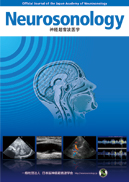巻号一覧

25 巻 (2012)
- 3 号 p. 137-
- 2 号 p. 79-
- 1 号 p. 5-
25 巻, 3 号
選択された号の論文の5件中1~5を表示しています
- |<
- <
- 1
- >
- >|
目で見る神経超音波診断
-
矢坂 正弘, 湧川 佳幸, 岡田 靖原稿種別: 目で見る神経超音波診断
2013 年 25 巻 3 号 p. 137-138
発行日: 2013/03/31
公開日: 2013/04/10
ジャーナル フリーPDF形式でダウンロード (901K)
症例報告
-
萩原 伸哉, 神原 瑞樹, 吉金 努, 高田 大慶, 大洲 光裕, 宮嵜 健史, 杉本 圭司, 上村 岳士, 永井 秀政, 秋山 恭彦原稿種別: 症例報告
2013 年 25 巻 3 号 p. 139-142
発行日: 2013/03/31
公開日: 2013/04/10
ジャーナル フリーA patient with a Chiari type 2 malformation underwent repair of a myelomeningocele 3 days after birth and received a ventricle-peritoneal shunt for congenital hydrocephalus 70 days after birth at another hospital. Later, he was brought to our hospital because of suspected shunt malfunction. A new shunt system was inserted when the patient was 18 months of age. We used transcranial sonography (TCS) to measure the cerebral ventricle size in preparation for postoperative shunt pressure adjustment. We had a problem in controlling the shunt function between the old tube and the new tube. By using TCS, we could immediately confirm the change in the ventricle size after pressure adjustment without frequent examinations by computed tomography or magnetic resonance imaging. The child’s mother was later found to have Munchausen syndrome by proxy. The clue to this diagnosis was the dissociation between the mother’s complaints and the child’s actual status, including the child’s shunt function assessed by TCS.抄録全体を表示PDF形式でダウンロード (3745K) -
木下 恵司原稿種別: 症例報告
2013 年 25 巻 3 号 p. 143-147
発行日: 2013/03/31
公開日: 2013/04/10
ジャーナル フリーWe report a neonatal case of tuberous sclerosis (TS) presenting two types of tubers on cranial ultrasound (US) images. Multiple cardiac rhabdomyomas (CRs) were detected at 36 weeks’ gestation by intrauterine US. Postnatally, the patient had no heart problems. On her second day after birth, she experienced generalized tonic clonic seizures. On the same day, tubers, white matter lesions, and subependymal nodules were recognized on her brain magnetic resonance imaging (MRI) scan. In addition, cranial US showed multiple brain lesions. The patient fulfilled the diagnostic criteria for TS. Two types of tubers were detected on US: an incomplete ring resembling a half-eaten doughnut and a solid mass. These could be observed more clearly with a 12-MHz linear probe than with a 7-MHz sector probe. If the fetal US examination had been performed with suitable probes, her brain lesions could have been prenatally detected. When CRs can be detected on fetal US, neuroimaging enables a rapid diagnosis of TS. In addition to genetic testing and the morphology of tubers as seen on MRI, it is likely that the types of tubers seen on US facilitate forecasting of the postnatal severity of the neuronal manifestations of TS.抄録全体を表示PDF形式でダウンロード (7256K) -
田中 弘二, 斎藤 こずえ, 佐藤 和明, 土井尻 遼介, 大塚 伸子, 古賀 政利, 豊田 一則, 長束 一行原稿種別: 症例報告
2013 年 25 巻 3 号 p. 148-152
発行日: 2013/03/31
公開日: 2013/04/10
ジャーナル フリーAn 85 year-old woman with hypertension and dyslipidemia was admitted with visual impairment, left hemiparesis, and sensory disturbance. A systolic bruit was not audible in her neck or supraclavicular fossa. Magnetic resonance imaging revealed a fresh infarct in the right occipital lobe and magnetic resonance angiography (MRA) showed occlusion of the right posterior cerebral artery (PCA). Carotid ultrasonography showed no stenotic lesions. We performed transesophageal echocardiography (TEE) and found a mobile lesion in the origin of the innominate artery. After several days, we performed real-time three-dimensional (3D) TEE for further evaluation. We found that the mobile lesion was stringy with a length of 2.7 cm and moving in a circle around the point of adhesion. We could also detect the lesion by ultrasonography with a sector probe from the superior thoracic aperture. The lesion could not be detected by cervical MRA or computed tomography angiography.
The patient had no cardiogenic embolic source such as atrial fibrillation or a right to left shunt. There was no abnormal vascular form of dissection or aneurysm. We considered the mobile thrombogenic lesion to have originated from a ruptured atherosclerotic plaque with thrombus.
3D TEE may be a useful method for real-time three-dimensional evaluation of a mobile lesion located in the innominate artery or aortic arch, which is often difficult to evaluate by other methods.抄録全体を表示PDF形式でダウンロード (5914K)
技術報告
-
門永 陽子, 野津 智子, 福間 恵美, 瀧川 晴夫, 阿武 雄一原稿種別: 技術報告
2013 年 25 巻 3 号 p. 153-156
発行日: 2013/03/31
公開日: 2013/04/10
ジャーナル フリーWe report the improvement of pain and activities of daily living in five patients who received botulinum toxin therapy with echo guidance for spasticity that developed as an aftereffect of cerebral infarction since November 2011. The medicine was injected into the pectoralis major, flexor digitorum superficialis, flexor digitorum profundus, flexor pollicis longus of the upper extremities, extensor halluces longus, and posterior tibial muscles, as well as the medial and lateral heads of the gastrocnemius muscle in the lower extremities. Use of echo guidance in botox therapy allows identification of the spastic muscle to be targeted and assessment of the direction and depth of injection. This method also allows identification of surrounding nerves and blood vessels, which permits an approach to the target muscle without damage to nerves and blood vessels.抄録全体を表示PDF形式でダウンロード (932K)
- |<
- <
- 1
- >
- >|